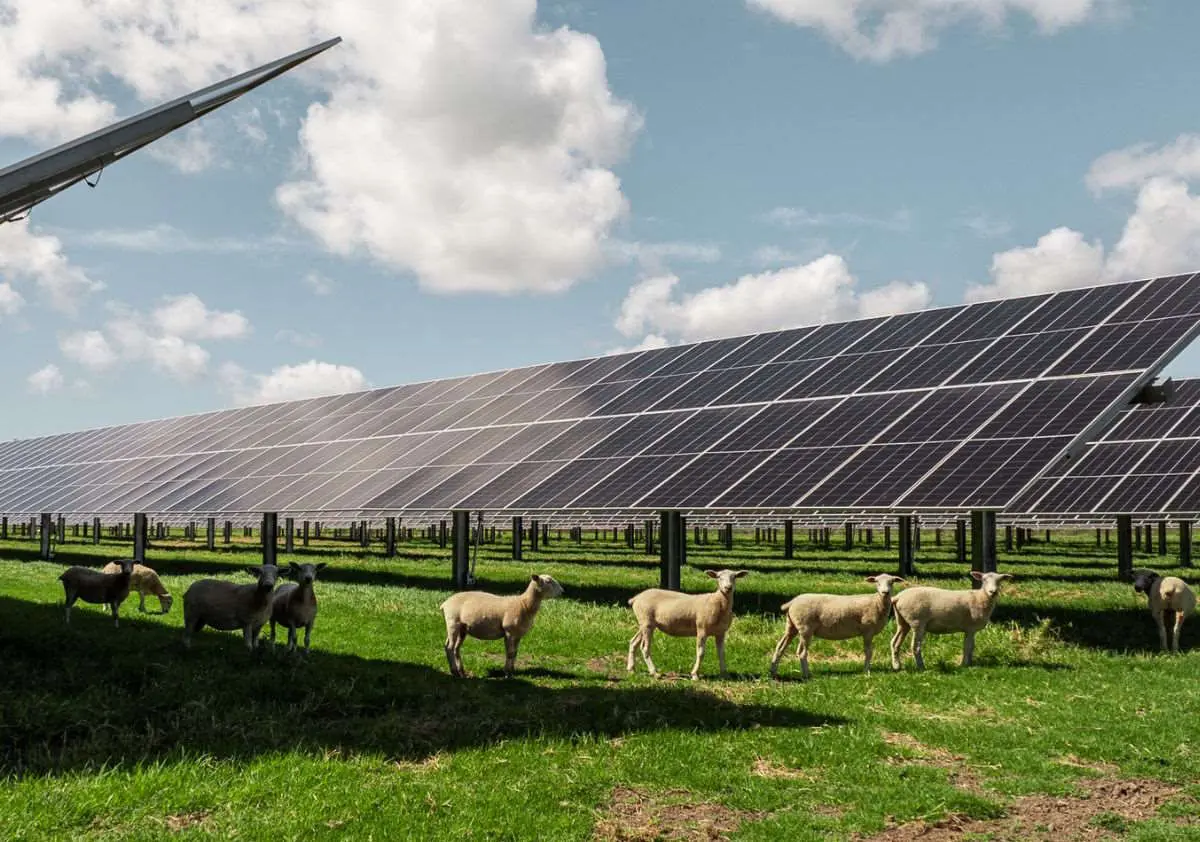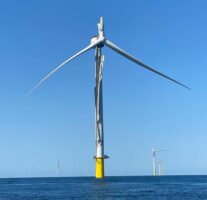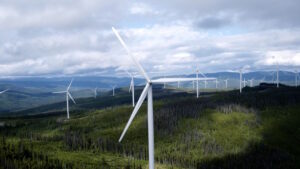The International Energy Agency has highlighted the falling cost of solar and lithium battery technology in its latest World Energy Outlook, which points to a surge in renewable energy deployments, an imminent peak for fossil fuels but still a shortfall in the deployments needed to meet crucial 1.5°C climate goals.
The WEO, released on Wednesday, points to an increasingly complex political and technology outlook, with wars in the Middle East and Ukraine and political divisions over key energy policies in many countries, particularly the US, that account for half of the world’s energy use.
The IEA says the global troubles underline the need for an accelerated transition to clean energy, for the sake of prices and energy security.
The good news, however, is that renewable deployment is already surging, led of course by China, and is getting within reach of the trebling of capacity by 2030 sought from the most recent global climate talks. The IEA says wind and solar hold the key to reaching those targets.
But electricity demand is also surging, driven by the electrification of transport and industry, the growth of data centres, and also of heat-waves driven by the very climate change that the transition to renewables is seeking to address.
That means that while the current growth in renewables will bring coal, gas and oil consumption to a peak this decade, it is still not enough to bring down emissions fast enough to meet the critical 1.5°C target. Based on current rather than intended policies, the world is heading to 2.4°C, and scientists say that could still be catastrophic.
The IEA’s annual WEO is one of the landmark annual publications in the energy world, even though the organisation is regularly criticised for failing to recognise the speed of the transition to renewables and EVs.
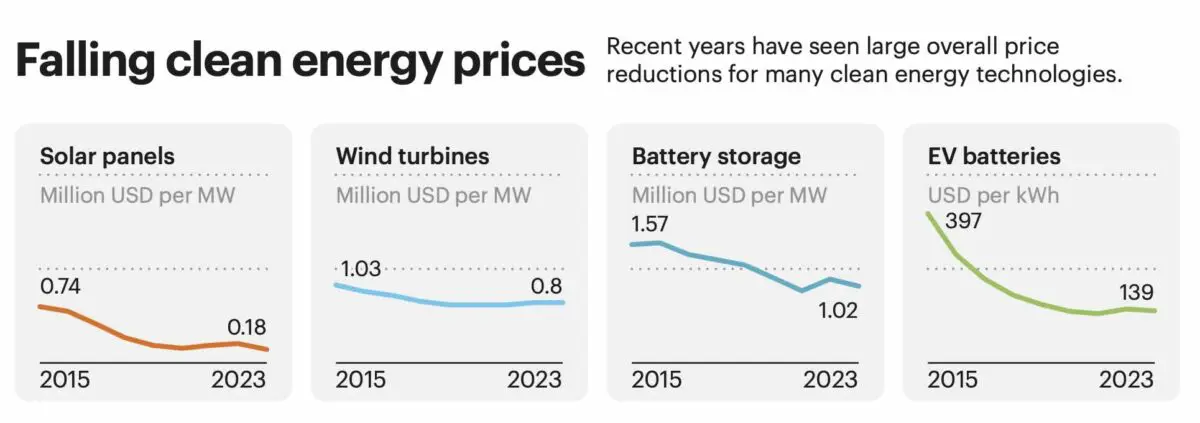
This time, however, it has upgraded its solar and battery forecasts for 2030 by around 24 per cent and 50 per cent respectively, driven mostly by plunging prices and the enormous manufacturing capacity built up in China.
It says an increase in wind and solar is essential if the world is to meet climate targets, because they are the only technologies that can be deployed quickly and at low cost.
“Solar PV and wind need to expand more than any other clean energy technologies to close the gap between the (the stated policies and the net zero scenarios), the IEA says. This will require an additional 7,000 terawatt-hours (TWh) of solar PV and 5,000 TWh of wind by 2035.
“The additional growth required in the NZE Scenario reflects the widespread availability of solar PV and wind, the strong policy support they enjoy in most countries and their cost advantages, since they are now the cheapest new sources of electricity in most markets,” it says.
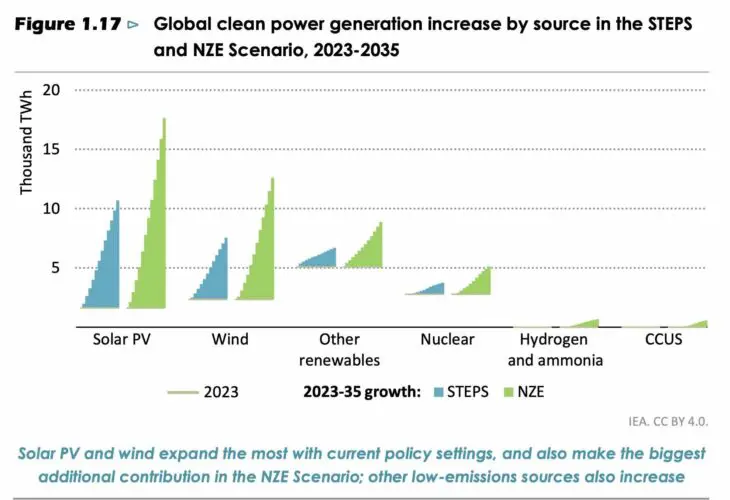
“In the case of solar PV, it also reflects the excess manufacturing capacity that already exists, and which is anticipated to augment in the coming years.”
The net zero policy scenario also calls for around 1,000 TWh of new hydro, and about 650 TWh of bioenergy, and it also identifies a gap of around 1,400 TWh of nuclear, although it notes this is being held back by costs and lead times.
“This is significant, but much smaller than those for solar PV and wind: not all countries choose to use nuclear technology, and it involves relatively high initial costs and long construction times,” it notes.
The WEO says that current policies are taking the world towards 2.4°C and intended policies towards 1.7°C. But it says there still remains a very narrow window to capping average global warming to below 1.5°Ç – but a lot will depend on China.
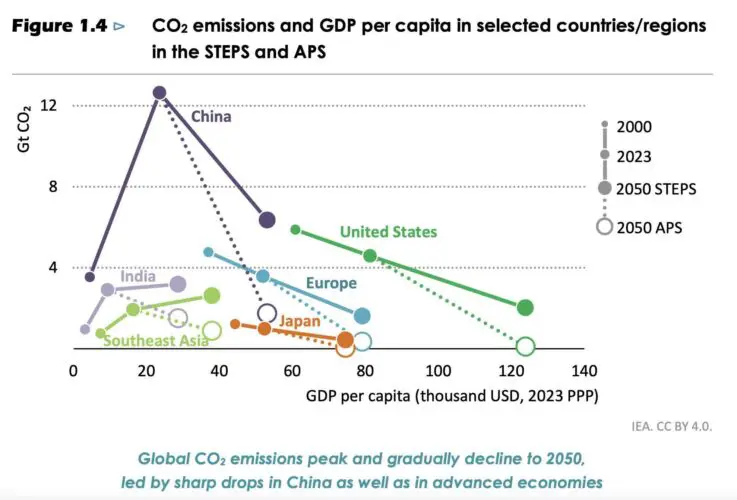
“CO2 emissions peak in all scenarios before 2030, but the subsequent rate of decline varies considerably,” it says. China is the biggest emitter in the world but is also on track to achieved the biggest reductions, even though it remains the world’s manufacturing base, and its emissions per capita are far inferior than the US and Europe.
Even in the state policies scenario, its emission cuts are far more significant than those of other countries and regions.
Dave Jones, a senior analyst for energy think tank Ember, says the IEA report shows that the boom of renewable electricity and electrification is enough to ensure the peak of coal, gas and oil this decade.
“And renewables are edging closer to achieving the COP28 pledge of tripling global renewables,” he said. “But with higher energy use even fast renewables growth doesn’t translate to fast falls in CO2 emissions.”
“Renewable growth is creating an energy abundance, but this will only translate into a substantive fall in CO2 emissions if there is simultaneously a strong focus on using energy as wastelessly as possible.”
Tim Buckley, from Climate Energy Finance, says the IEA report is still likely to be underestimating the deployment of renewables.
“Each year the IEA upgrades their renewable energy estimates, having underestimated the deflation of solar and BESS, and underestimating the technology improvements in cleantech as well – wind, solar, BESS and EVs,” Buckley says.
“As such, the IEA’s expectation of peaks in all types of fossil fuel energy types is likely still too conservative. This is great news, as clearly global scientists have likewise underestimated the compounding impacts of climate change.
“China clearly leads the world in both the manufacturing, domestic installation and export of all cleantech aspects.
“And, with China now pivoting its ‘going global’ to providing finance, manufacturing and engineering to help developing countries build out their own cleantech deployments, this is likely the next leg of global upgrades to zero emissions technologies deployments.”
Climate councillor Greg Bourne, noted that the WEO highlights that Australia’s uptake of renewables has been the most rapid globally over the last five years, driven by households and businesses taking up rooftop solar.
“Australia doesn’t need any new coal or gas,” he said in a statement.
“The International Energy Agency laid out our energy options and all of them point directly to building out clean sources of energy like solar and wind, which Australia has in abundance. Rapidly cutting climate pollution from polluting coal and gas is imperative so Australia keeps up with the global trend.
“Our own research echoes this, showing that if Australia stopped opening new gas projects today, supply from existing projects could meet our shrinking domestic gas needs for more than six decades — a clear signal that it’s time to power past gas, and turbocharge our switch to clean energy.“

